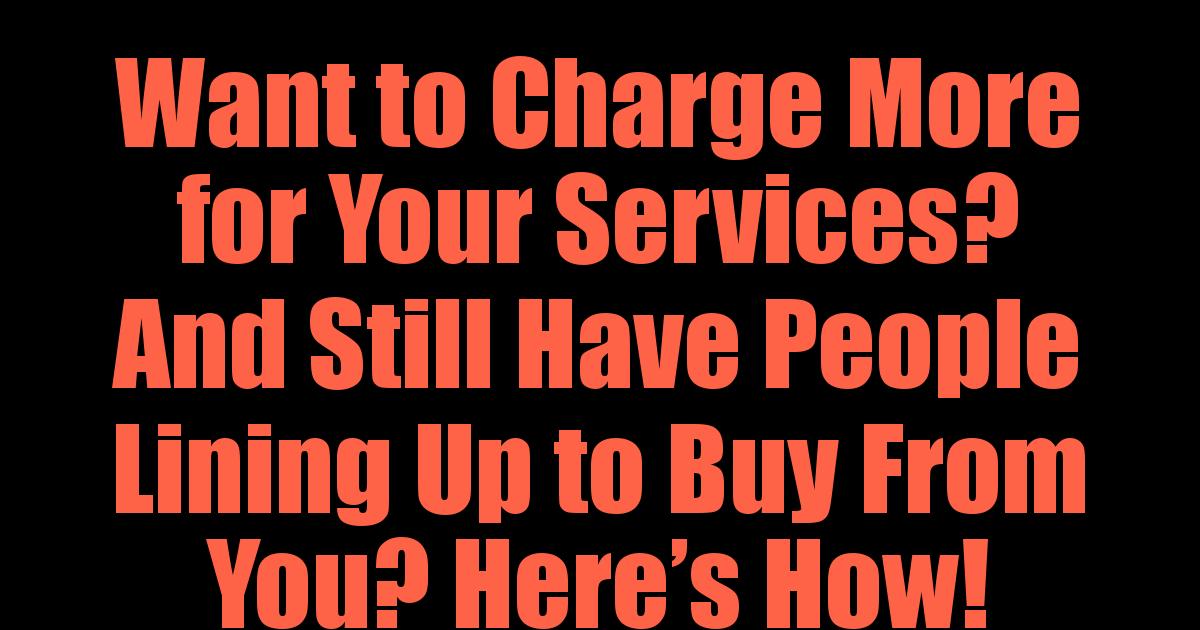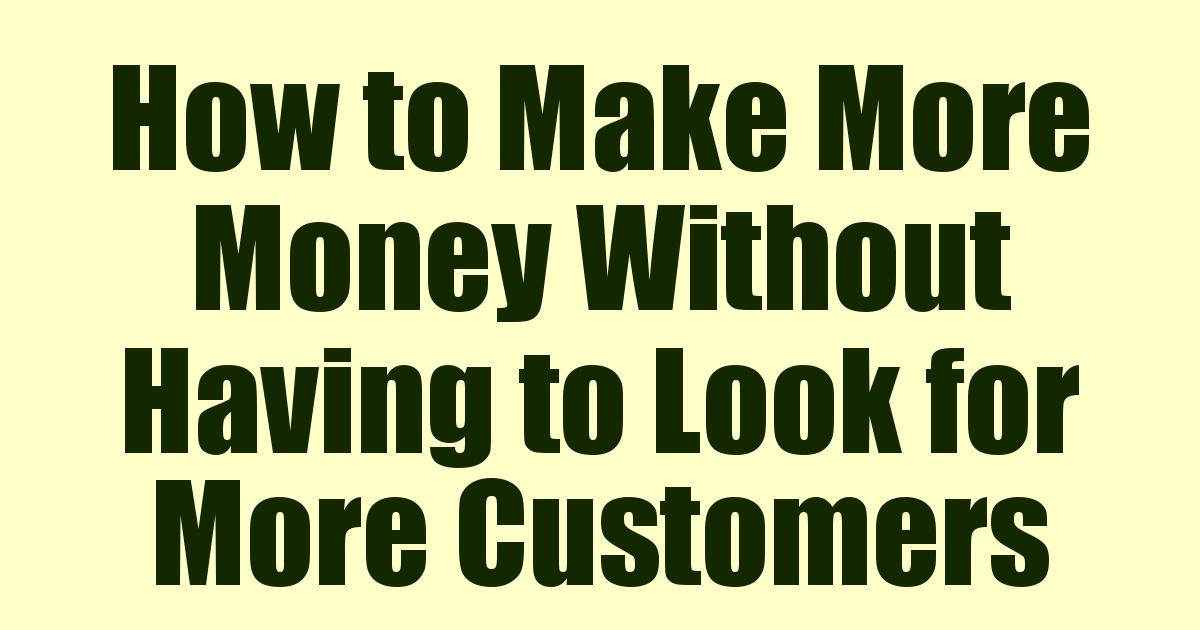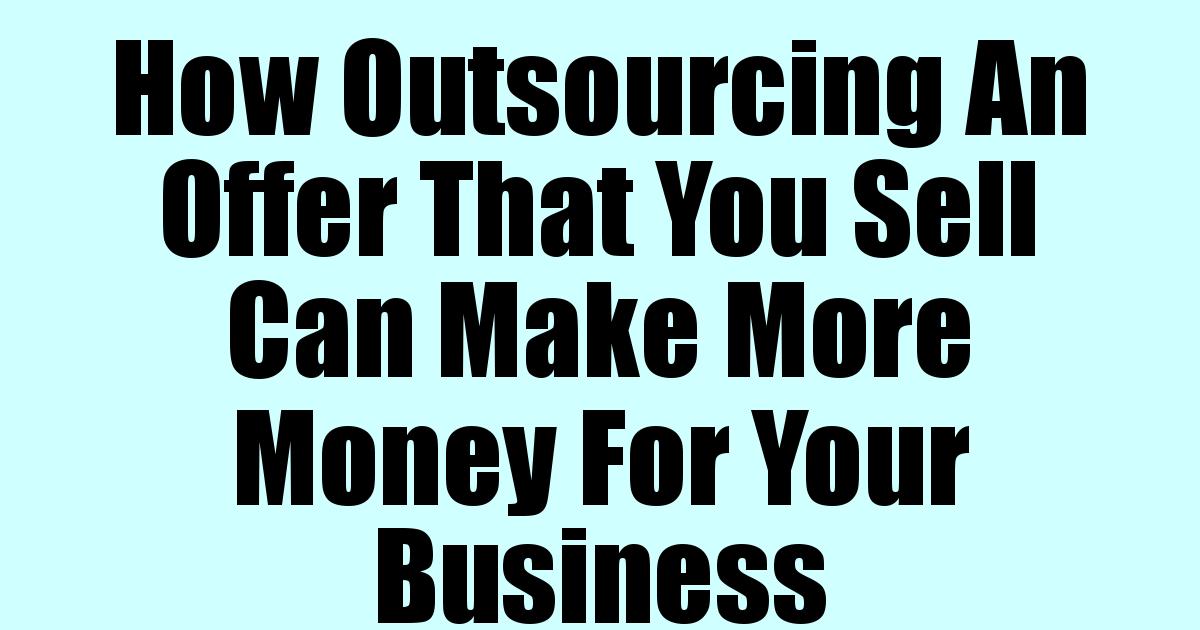 So how can you charge more for your services? How can you increase your price tag and still have customers lining up to buy from you? One easy way is to change your offer from a simple product/service to a done-for-you offer. What does this mean? Check out this example below.
So how can you charge more for your services? How can you increase your price tag and still have customers lining up to buy from you? One easy way is to change your offer from a simple product/service to a done-for-you offer. What does this mean? Check out this example below.
Say, instead of charging $5 to write an article, you instead charge $497 to $997+ to write five articles, create a blog, post the articles up, optimize it for their keywords, and have a custom graphic or two. If you were to outsource a $5 article for $3, the first example only gives you a $2 profit, or if you were to write it yourself, you'd be trading $5 for 30 minutes, at best, of your time ($10 an hour on the higher end if you’re super fast). However, if you were to offer the second, more premium example, you could outsource the articles for $15, allocate $10 for some custom graphics on Fiverr.com, and put in $25 to $50 to outsource the custom blog with SEO (blogger.com blogs, for instance, can be made in a matter of minutes). That's a raw cost of $50 to $100 for a $400 to $950 profit. Or, if you were to do the work mostly yourself, you'd be talking about maybe 3 to 5 hours of work, easily putting you in the range of earning $100 to $200+ per hour compared to $10 per hour just selling a $5 article.
So, see what you can add to your offer, or bundle it with, to make it a more premium offer. Or, look at how you can make your offer more “done-for-you.” and price your offer respectively. The kicker is that more people like to buy a premium offer than a basic offer, as it's more appealing and more "done-for-you" than just an item that they'd have to do all the rest of the work on themselves. And less people offer premium services/offers, so you're competing against less.
This doesn’t just apply to services either, as the same can be done for almost any kind of product out there. For instance, instead of just selling a book on how to lose weight, you could also sell a product or program that gives them daily exercises either through e-mail, a mobile app, software, etc.. So instead of someone just reading how to lose weight, you can make it more easy and “done for you” by literally giving them a way where they simply have to follow the daily tip. Or instead of selling a 50¢ apple at a gas station, one could sell a pre-sliced apple with caramel dipping sauce ready to go for $4+ (even though the raw cost is only a tinge more than the standard apple).
One great example we’ve done is instead of selling a course on how to rank on search engines and get traffic, which would be a challenge to sell even in the $25 to $50 range, we created software that helps do a lot of those tasks for people. And instead of having a challenge of selling a course for $25 to $50, we can charge $997 / year to $2,997 / year much more easily. We’re able to do that because it’s more “done for you” and involves far less time for the end user.
A similar example outside of software was with a real estate investing instructor that we know of who at one point sold several courses on how to invest in real estate. Most of these courses originally were on the lower end of the price point, but she was able to turn those “books” into “webinar trainings” and online courses and charge closer to $997 on up, but she didn’t stop there. She was able to partner with one of us to create software that helped do what she was teaching and sold it for around $4,000 a pop. But she still didn’t stop there. She then took all her teachings and tools and basically made an offer that would be as hands free as possible for the user. That was accomplished by setting up an offer where you’d be able to purchase a $25,000 package where you’d get on a bus with others, tour dozens and dozens of homes in a day that they already did the math on and knew were awesome deals, and then be able to make offers on the spot with bankers, agents, mortgage brokers, etc. all right there with you in one place. Granted, this wasn’t for the average mom and pop investor, but for some big investors, including overseas ones looking to take advantage of the U.S. market at the time, this was an opportunity to jump into it as hands free as possible. And they were willing to pay for it.
An interesting twist on making any offer more premium or done for you is that it doesn’t have to always start with your own product or service! You can find existing service providers or products out there, see how you can make them better / more “done for you,” and then try to either form a partnership with them or just use the outsourced provider to fulfill the work for a service. A few simple tweaks to their package / offer and sales pitch can turn a $5 offer into a $500 or even a $5,000 one without even having the need to make your own offer from scratch!
Now start looking at how you can apply this to your business. How can you make your offer a premium or “done-for-you” offer by adding more things to your service or bundling your products together to give more value? This then allows you to increase your prices substantially, your premium pricing reflecting your premium product.
Now you have ideas for a premium product, need help getting leads to sell this to? For help with how to get leads to promote your product or service to, check out this cool tool: Domain Lead Pro.
 It’s time to check out the competition!! In school it may have been called cheating, but in the business world it’s just good old-fashioned market research!
It’s time to check out the competition!! In school it may have been called cheating, but in the business world it’s just good old-fashioned market research!
 It’s often a lot easier to sell to your current customers than to get a new customer. They already like and trust you and know your product/service works. Tap into that opportunity by looking at what else you can sell to your customers that compliments what they bought previously.
It’s often a lot easier to sell to your current customers than to get a new customer. They already like and trust you and know your product/service works. Tap into that opportunity by looking at what else you can sell to your customers that compliments what they bought previously.
 Sometimes it’s hard to see the benefit of something we haven’t seen in action or tried first. Offering a free trial period, or a demonstration of your product, can be a great way to alleviate a potential customer’s fears and make them confident the product will work for them. Also, once someone has tried something free they often feel obliged to reciprocate by purchasing from you - it’s the principle of reciprocity in action.
Sometimes it’s hard to see the benefit of something we haven’t seen in action or tried first. Offering a free trial period, or a demonstration of your product, can be a great way to alleviate a potential customer’s fears and make them confident the product will work for them. Also, once someone has tried something free they often feel obliged to reciprocate by purchasing from you - it’s the principle of reciprocity in action.
 People often overlook this very simple, very easy way to increase their business’s profits: increase your prices. Most people tend to undercharge for their services, so try increasing your prices, as a test, and see what happens. Funnily enough, most people perceive something that is higher priced as being of higher quality, which can encourage people to buy your product or service. As you increase your prices, you’re also receiving more per sale, increasing your profit margin. Take this strategy a step further and target higher value clients.
People often overlook this very simple, very easy way to increase their business’s profits: increase your prices. Most people tend to undercharge for their services, so try increasing your prices, as a test, and see what happens. Funnily enough, most people perceive something that is higher priced as being of higher quality, which can encourage people to buy your product or service. As you increase your prices, you’re also receiving more per sale, increasing your profit margin. Take this strategy a step further and target higher value clients.
 There’s only so much time in the day, and although it can be a great idea to add extra services that you sell and fulfill yourself, it’s not always practical. This is why it can be a great idea to look for other services or offers that you can sell yourself but easily outsource to others to do with little to no work on your part.
There’s only so much time in the day, and although it can be a great idea to add extra services that you sell and fulfill yourself, it’s not always practical. This is why it can be a great idea to look for other services or offers that you can sell yourself but easily outsource to others to do with little to no work on your part.
 Any special promotions can help you drive sales, especially those sitting on the fence as to whether or not to buy from you. However, offering seasonal or holiday themed promotions can help even more, as prospects not only immediately understand that it’s a limited time deal for a good reason, but you’ll also hit them up during a peak buying period.
Any special promotions can help you drive sales, especially those sitting on the fence as to whether or not to buy from you. However, offering seasonal or holiday themed promotions can help even more, as prospects not only immediately understand that it’s a limited time deal for a good reason, but you’ll also hit them up during a peak buying period.